Spatio-Temporal Characteristics of the Evapotranspiration in the Lower Mekong River Basin during 2008–2017
Abstract
:1. Introduction
2. Study Area and Data
2.1. Study Area
2.2. Data
3. Methodology
3.1. ET Estimation
3.2. Data Analysis Methods
3.2.1. Radionov Time Series Analysis
3.2.2. Sliding Filter Analysis
3.2.3. Sen + MK Variation Trend Analysis
3.3. Accuracy Evaluation Method
4. Results
4.1. Cross Validation with MOD16
4.2. Temporal Characteristics of ET
4.3. Spatial Characteristics of ET
5. Discussion
5.1. Change of Land Cover and Their Impact on ET
5.2. Influence of Meteorological Factors on ET
6. Conclusions
Author Contributions
Funding
Data Availability Statement
Acknowledgments
Conflicts of Interest
References
- Bates, B.C.; Kundzewicz, Z.W.; Wu, S.; Palutikof, J.P.; Arnell, N. Climate Change and Water; Technical Paper of the Intergovernmental Panel on Climate Change; IPCC: Geneva, Switzerland, 2008. [Google Scholar]
- Monteith, J.L. Evaporation, evapotranspiration and climatic data. J. Hydrol. 1997, 190, 167–168. [Google Scholar] [CrossRef]
- Brutsaert, W. The Surface Roughness Parameterization; Springer: Dutch, The Netherlands, 1982. [Google Scholar]
- Stocker, T.F. Climate Change 2013: The Physical Science Basis. Contribution of Working Group I to the Fifth Assessment Report of IPCC the Intergovernmental Panel on Climate Change; AGU Fall Meeting Abstracts; IPCC: Geneva, Switzerland, 2014. [Google Scholar]
- Thompson, J.R.; Green, A.J.; Kingston, D.G.; Todd, M.C.; Richard, G.T. Potential Evapotranspiration-Related Uncertainty in Climate Change Impacts on River Flow: An Assessment for the Mekong River Basin. J. Hydrol. 2014, 510, 503–523. [Google Scholar] [CrossRef] [Green Version]
- Oki, T.; Kanae, S. Global Hydrological Cycles and World Water Resources. Science 2006, 313, 1068–1072. [Google Scholar] [CrossRef] [PubMed] [Green Version]
- Wang, S.D.; Chen, X.; Liu, S.H.; Kai, Y.U.; Zhou, S.J. A Review on Monitoring Models of Arid Area Using Remote Sensing. Remote Sens. Inf. 2006. [Google Scholar] [CrossRef]
- Tirivarombo, S.; Osupile, D.; Eliasson, P. Drought monitoring and analysis: Standardised Precipitation Evapotranspiration Index (SPEI) and Standardised Precipitation Index (SPI). Phys. Chem. Earth Parts A/B/C 2018, 106, 1–10. [Google Scholar] [CrossRef]
- Song, L.; Liu, S.; Kustas, W.P.; Nieto, H.; Sun, L.; Xu, Z.; Skaggs, T.H.; Yang, Y.; Ma, M.; Xu, T.; et al. Monitoring and Validating Spatially and Temporally Continuous Daily Evaporation and Transpiration at River Basin Scale. Remote Sens. Environ. 2018, 219, 72–88. [Google Scholar] [CrossRef]
- Di, L.; Singh, V.P. Assessing the Impact of End-Member Selection on the Accuracy of Satellite-Based Spatial Variability Models for Actual Evapotranspiration Estimation. Water Resour. Res. 2013, 49, 2601–2618. [Google Scholar]
- Anderson, M.C.; Allen, R.G.; Morse, A.; Kustas, W.P. Use of Landsat Thermal Imagery in Monitoring Evapotranspiration and Managing Water Resources. Remote Sens. Environ. 2012, 122, 50–65. [Google Scholar] [CrossRef]
- Jackson, R.D.; Idso, S.B.; Reginato, R.J.; Pinter, P.J., Jr. Canopy Temperature as a Crop Water Stress Indicator. Water Resour. Res. 1981, 17, 1133–1138. [Google Scholar] [CrossRef]
- Yang, Y.; Shang, S.; Jiang, L. Remote Sensing Temporal and Spatial Patterns of Evapotranspiration and the Responses to Water Management in a Large Irrigation District of North China. Agric. For. Meteorol. 2012, 164, 112–122. [Google Scholar] [CrossRef]
- Cosslett, T.L.; Cosslett, P.D. The Lower Mekong Basin: Rice Production, Climate Change, ENSO, and Mekong Dams. In Sustainable Development of Rice and Water Resources in Mainland Southeast Asia and Mekong River Basin; Springer: Dordrecht, The Netherlands, 2018; pp. 85–114. [Google Scholar] [CrossRef]
- Zhang, X.; Liu, H. Analysis of Drought Character in the Mekong River Basin. In Flood Prevention and Drought Relief in Mekong River Basin; Springer: Dordrecht, The Netherlands, 2020; pp. 95–107. [Google Scholar] [CrossRef]
- Chen, X.; Zheng, Y.; Xu, B.; Wang, L.; Han, F.; Zhang, C. Balancing Competing Interests in the Mekong River Basin via the Operation of Cascade Hydropower Reservoirs in China: Insights from System Modeling. J. Clean. Prod. 2020, 254, 119967. [Google Scholar] [CrossRef]
- Hu, Y.; Maskey, S.; Uhlenbrook, S. Downscaling Daily Precipitation over the Yellow River Source Region in China: A Comparison of Three Statistical Downscaling Methods. Arch. Meteorol. Geophys. Bioclimatol. Ser. B 2012, 112, 447–460. [Google Scholar] [CrossRef]
- Wang, W.; Lu, H.; Yang, D.; Sothea, K.; Jiao, Y.; Gao, B.; Peng, X.; Pang, Z. Modelling Hydrologic Processes in the Mekong River Basin Using a Distributed Model Driven by Satellite Precipitation and Rain Gauge Observations. PLoS ONE 2016, 11, e0152229. [Google Scholar] [CrossRef] [PubMed] [Green Version]
- Bo, X.; Yu, L.; Han, F.; Zheng, Y.; Ding, W.; Zhang, C.; Wallington, K.; Zhang, Z. The Transborder Flux of Phosphorus in the Lancang-Mekong River Basin: Magnitude, Patterns and Impacts from the Cascade Hydropower Dams in China. J. Hydrol. 2020, 590, 125201. [Google Scholar]
- Gu, Z.; Fan, H.; Wang, Y. Dynamic Characteristics of Sandbar Evolution in the Lower Lancang-Mekong River between 1993 and 2012 in the Context of Hydropower Development. Estuar. Coast. Shelf Sci. 2020, 237, 106678. [Google Scholar] [CrossRef]
- Hecht, J.S.; Lacombe, G.; Arias, M.E.; Dang, T.D.; Piman, T. Hydropower Dams of the Mekong River Basin: A Review of Their Hydrological Impacts. J. Hydrol. 2019, 568, 285–300. [Google Scholar] [CrossRef]
- Liu, S.; Li, X.; Chen, D.; Duan, Y.; Ji, H.; Zhang, L.; Chai, Q.; Hu, X. Understanding Land Use/Land Cover Dynamics and Impacts of Human Activities in the Mekong Delta over the Last 40 Years. Glob. Ecol. Conserv. 2020, 22, e00991. [Google Scholar] [CrossRef]
- Chen, X.; Lui, H.; Mu, X. Summary of Flood and Drought in Mekong River Basin. In Flood Prevention and Drought Relief in Mekong River Basin; Springer: Dordrecht, The Netherlands, 2020; pp. 27–54. [Google Scholar]
- Andrews, D.G. Frontmatter. In An Introduction to Atmospheric Physics; Cambridge University Press: Cambridge, UK, 2010. [Google Scholar]
- Liu, Y. Hydrologic Remote Sensing; CRC Press: Boca Raton, FL, USA, 2016. (In Chinese) [Google Scholar]
- Wang, K.; Dickinson, R.E. A Review of Global Terrestrial Evapotranspiration: Observation, Modeling, Climatology, and Climatic Variability. Rev. Geophys. 2012, 50, 2. [Google Scholar] [CrossRef]
- Wild, M. Solar radiation budgets in atmospheric model intercomparisons from a surface perspective. Geophys. Res. Lett. 2005, 32, 99–119. [Google Scholar] [CrossRef]
- Trenberth, K.E.; Fasullo, J.T.; Kiehl, J. Earth′s Global Energy Budget. Bull. Am. Meteorol. Soc. 2009, 90, 311–323. [Google Scholar] [CrossRef]
- Li, Z.-L.; Tang, R.; Wan, Z.; Bi, Y.; Zhou, C.; Tang, B.; Yan, G.; Zhang, X. A Review of Current Methodologies for Regional Evapotranspiration Estimation from Remotely Sensed Data. Sensors 2009, 9, 3801–3853. [Google Scholar] [CrossRef] [PubMed] [Green Version]
- Jiang, L.; Islam, S. A Methodology for Estimation of Surface Evapotranspiration over Large Areas Using Remote Sensing Observations. Geophys. Res. Lett. 1999, 26, 2773–2776. [Google Scholar] [CrossRef] [Green Version]
- Bastiaanssen, W. SEBAL-Based Sensible and Latent Heat Fluxes in the Irrigated Gediz Basin, Turkey. J. Hydrol. 2000, 229, 87–100. [Google Scholar] [CrossRef]
- Su, Z. The Surface Energy Balance System (SEBS) for Estimation of Turbulent Heat Fluxes. Hydrol. Earth Syst. Sci. 2002, 6, 85–100. [Google Scholar] [CrossRef]
- Xiong, Y.; Qiu, G.Y. Estimation of Evapotranspiration Using Remotely Sensed Land Surface Temperature and the Revised Three-Temperature Model. Int. J. Remote Sens. 2011, 32, 5853–5874. [Google Scholar] [CrossRef]
- Hu, S.; Mo, X. Attribution of Long-Term Evapotranspiration Trends in the Mekong River Basin with a Remote Sensing-Based Process Model. Remote Sens. 2021, 13, 303. [Google Scholar] [CrossRef]
- Mekong River Comission. Planning Altas of the Lower Mekong River Basin; Mekong River Comission: Vientiane, Laos, 2013. [Google Scholar]
- Baiyinbaoligao. Overview of the Mekong River Basin; Mekong River Comission: Vientiane, Laos, 2020. [Google Scholar]
- Meynell, P.J. Wetlands of the Mekong River Basin, an Overview; Springer: Dordrecht, The Netherlands, 2017. [Google Scholar]
- Shi, C. Status and Plans of CMA Land Data Assimilation System (CLDAS) Project; EGU General Assembly Conference EGU General Assembly Conference Abstracts; EGU: Munich, Germany, 2014. [Google Scholar]
- Mu, Q.; Heinsch, F.A.; Zhao, M.; Running, S.W. Development of a Global Evapotranspiration Algorithm Based on MODIS and Global Meteorology Data. Remote Sens. Environ. 2007, 111, 519–536. [Google Scholar] [CrossRef]
- Friedl, M.A.; Sulla-Menashe, D.; Tan, B.; Schneider, A.; Ramankutty, N.; Sibley, A.; Huang, X. MODIS Collection 5 Global Land Cover: Algorithm Refinements and Characterization of New Datasets. Remote Sens. Environ. 2010, 114, 168–182. [Google Scholar] [CrossRef]
- Liu, Y.; Hiyama, T.; Yasunari, T.; Tanaka, H. A Nonparametric Approach to Estimating Terrestrial Evaporation: Validation in Eddy Covariance Sites. Agric. For. Meteorol. 2012, 157, 49–59. [Google Scholar] [CrossRef]
- Xin, P.; Liu, Y. Spatio-Temporal Variation of Surface Net Radiation over the Yangze River Basin during 1983–2012. Resour. Environ. Yangtze Basin 2016, 25, 486–496. [Google Scholar]
- Pan, X.; Liu, Y.; Gan, G.; Fan, X.; Yang, Y. Estimation of Evapotranspiration Using a Nonparametric Approach under All Sky: Accuracy Evaluation and Error Analysis. IEEE J. Sel. Top. Appl. Earth Obs. Remote Sens. 2017, 10, 2528–2539. [Google Scholar] [CrossRef]
- Pan, X.; You, C.; Liu, Y.; Shi, C.; Han, S.; Yang, Y.; Hu, J. Evaluation of Satellite-Retrieved Evapotranspiration Based on a Nonparametric Approach over an Arid Region. Int. J. Remote Sens. 2020, 41, 7605–7623. [Google Scholar] [CrossRef]
- Moran, M.; Jackson, R.D.; Raymond, L.H.; Gay, L.W.; Slater, P.N. Mapping Surface Energy Balance Components by Combining Landsat Thematic Mapper and Ground-Based Meteorological Data. Remote Sens. Environ. 1989, 30, 77–87. [Google Scholar] [CrossRef]
- Rodionov, S.N. A Sequential Method for Detecting Regime Shifts in the Mean and Variance; University of Washington: Seattle, WA, USA, 2005; pp. 68–72. [Google Scholar]
- Marty, C. Regime Shift of Snow Days in Switzerland. Geophys. Res. Lett. 2008, 35, 62–77. [Google Scholar] [CrossRef] [Green Version]
- Pan, X.; Liu, Y.; Fan, X. Satellite Retrieval of Surface Evapotranspiration with Nonparametric Approach: Accuracy Assessment over a Semiarid Region. Adv. Meteorol. 2016, 2016, 1584316. [Google Scholar] [CrossRef] [Green Version]
- Li, M.; Chu, R.; Islam, A.R.M.T.; Shen, S. Characteristics of Surface Evapotranspiration and Its Response to Climate and Land Use and Land Cover in the Huai River Basin of Eastern China. Environ. Sci. Pollut. Res. 2021, 28, 683–699. [Google Scholar] [CrossRef]
- Sawano, S.; Hotta, N.; Komatsu, H.; Suzuki, M.; Yayama, T. Evaluation of Evapotranspiration in Forested Areas in the Mekong Basin Using GIS Data Analysis. In Forest Environments in the Mekong River Basin; Sawada, H., Araki, M., Chappell, N.A., LaFrankie, J.V., Shimizu, A., Eds.; Springer: Tokyo, Japan, 2007; pp. 36–44. [Google Scholar] [CrossRef]
- Tang, X.; Woodcock, C.E.; Olofsson, P.; Hutyra, L.R. Spatiotemporal Assessment of Land Use/Land Cover Change and Associated Carbon Emissions and Uptake in the Mekong River Basin. Remote Sens. Environ. 2021, 256, 112336. [Google Scholar] [CrossRef]
- Liu, J.; Zhang, Q.; Xu, C.; Jin, X. Change of Actual Evapotranspiration of Poyang Lake Watershed and Associated Influencing Factors in the past 50 Years. Resour. Environ. Yangtze Basin 2010, 4, 197–203. [Google Scholar]
- Li, X.; Liu, L.; Duan, Z.; Wang, N. Spatio-Temporal Variability in Remotely Sensed Surface Soil Moisture and Its Relationship with Precipitation and Evapotranspiration during the Growing Season in the Loess Plateau, China. Environ. Earth Sci. 2014, 71, 1809–1820. [Google Scholar] [CrossRef]
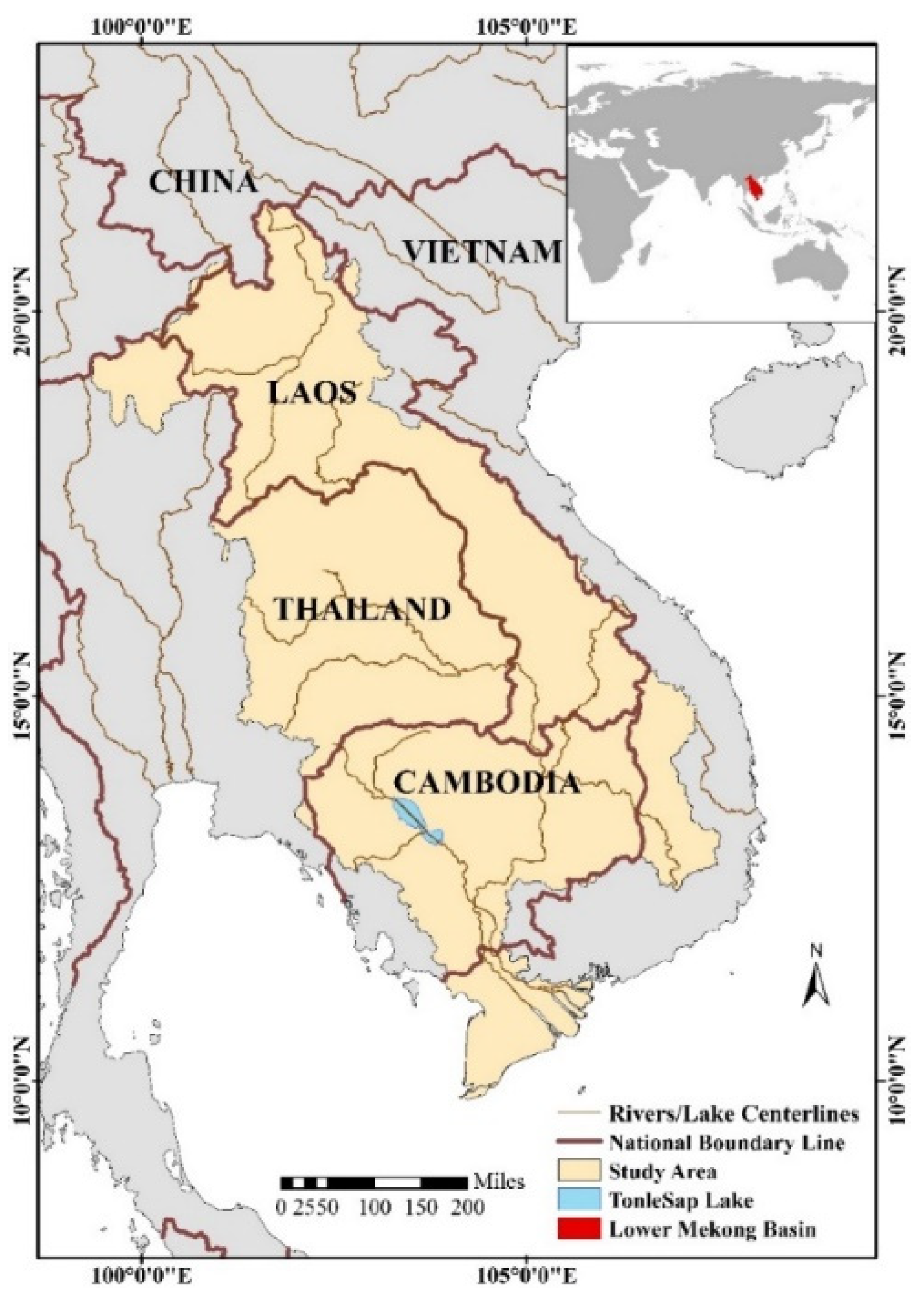
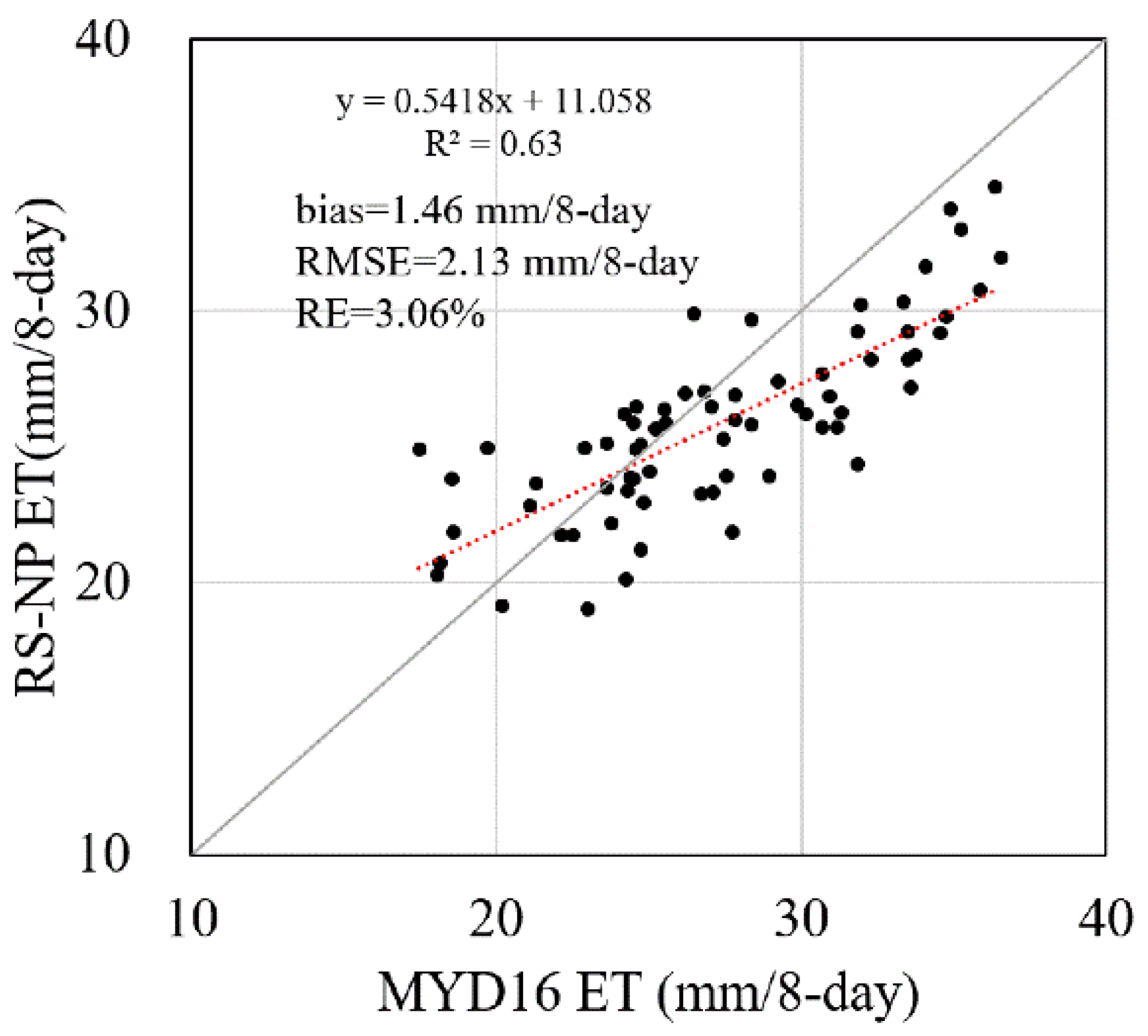
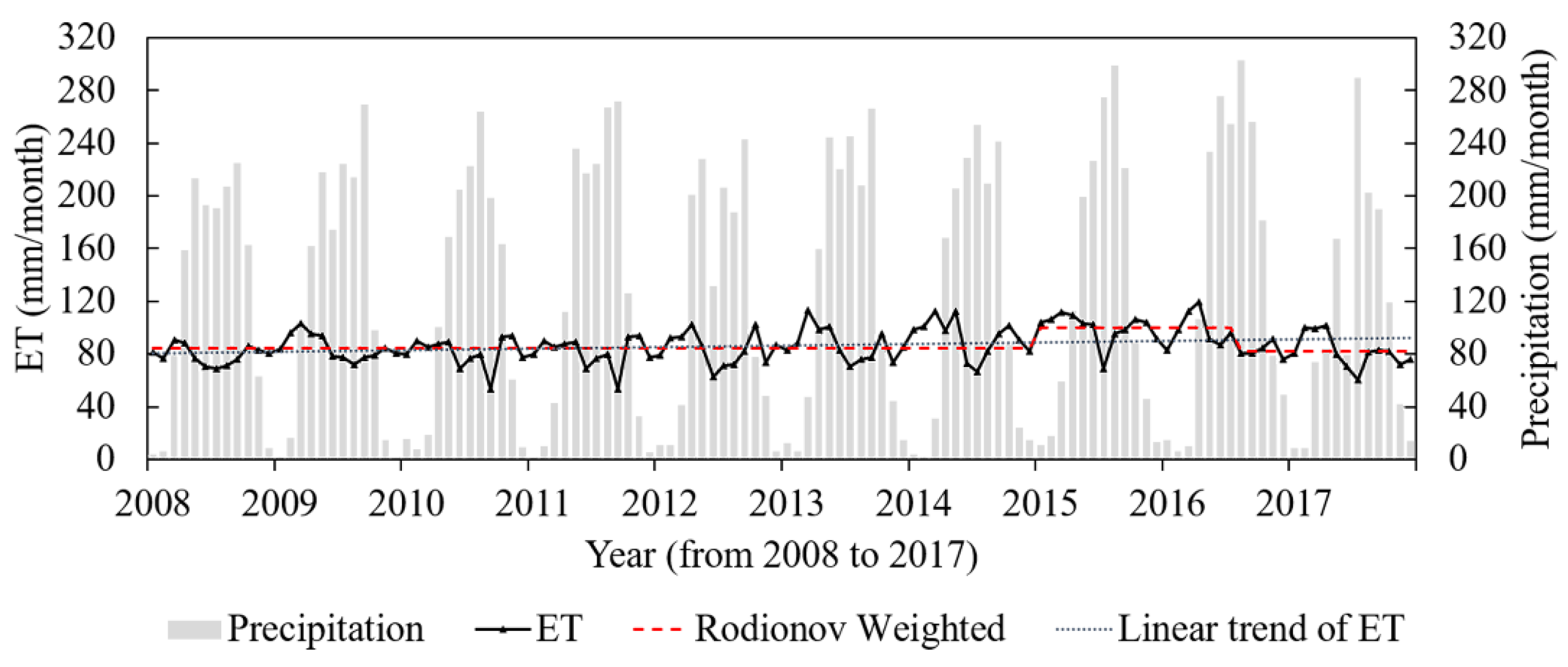

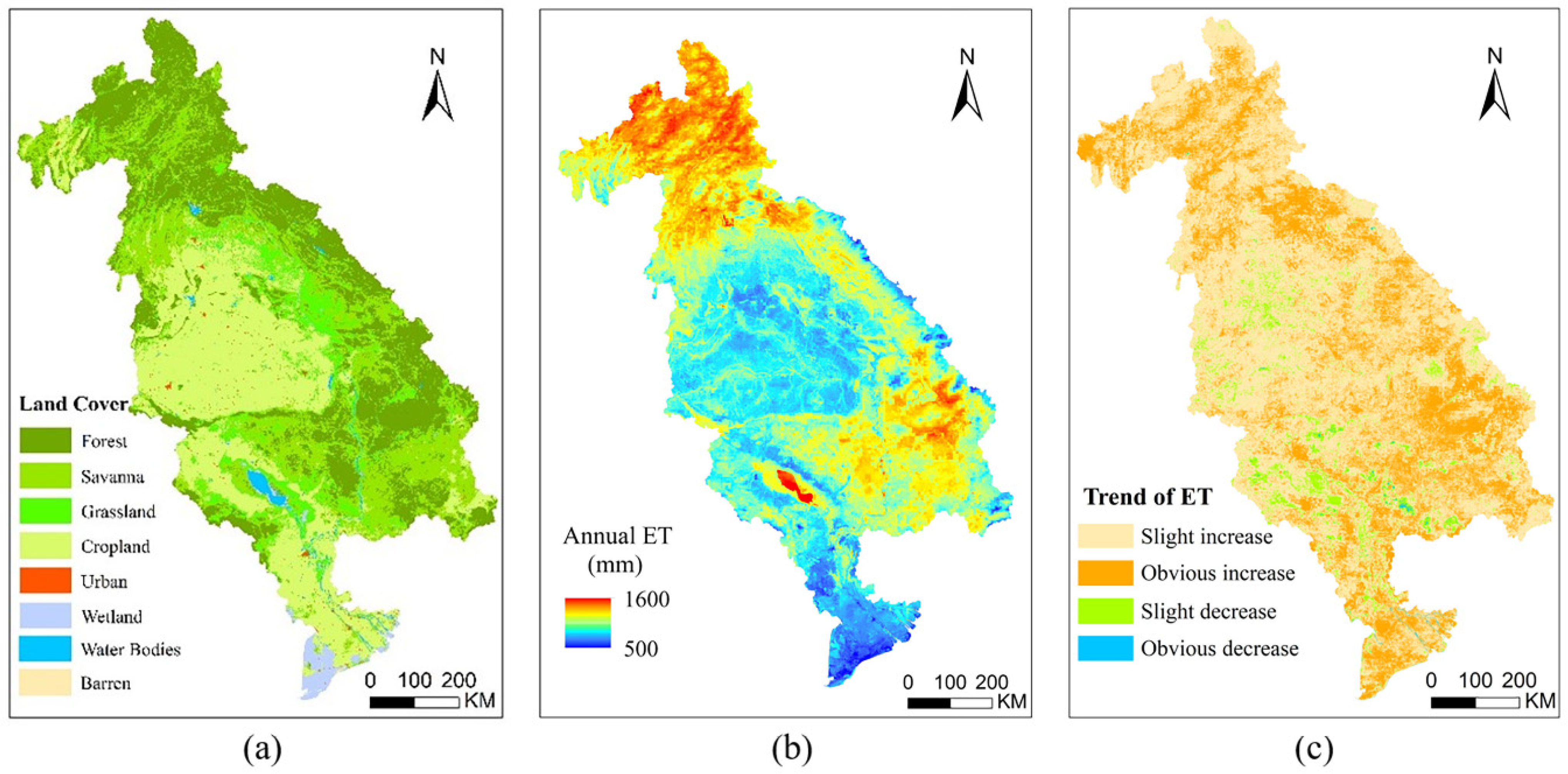
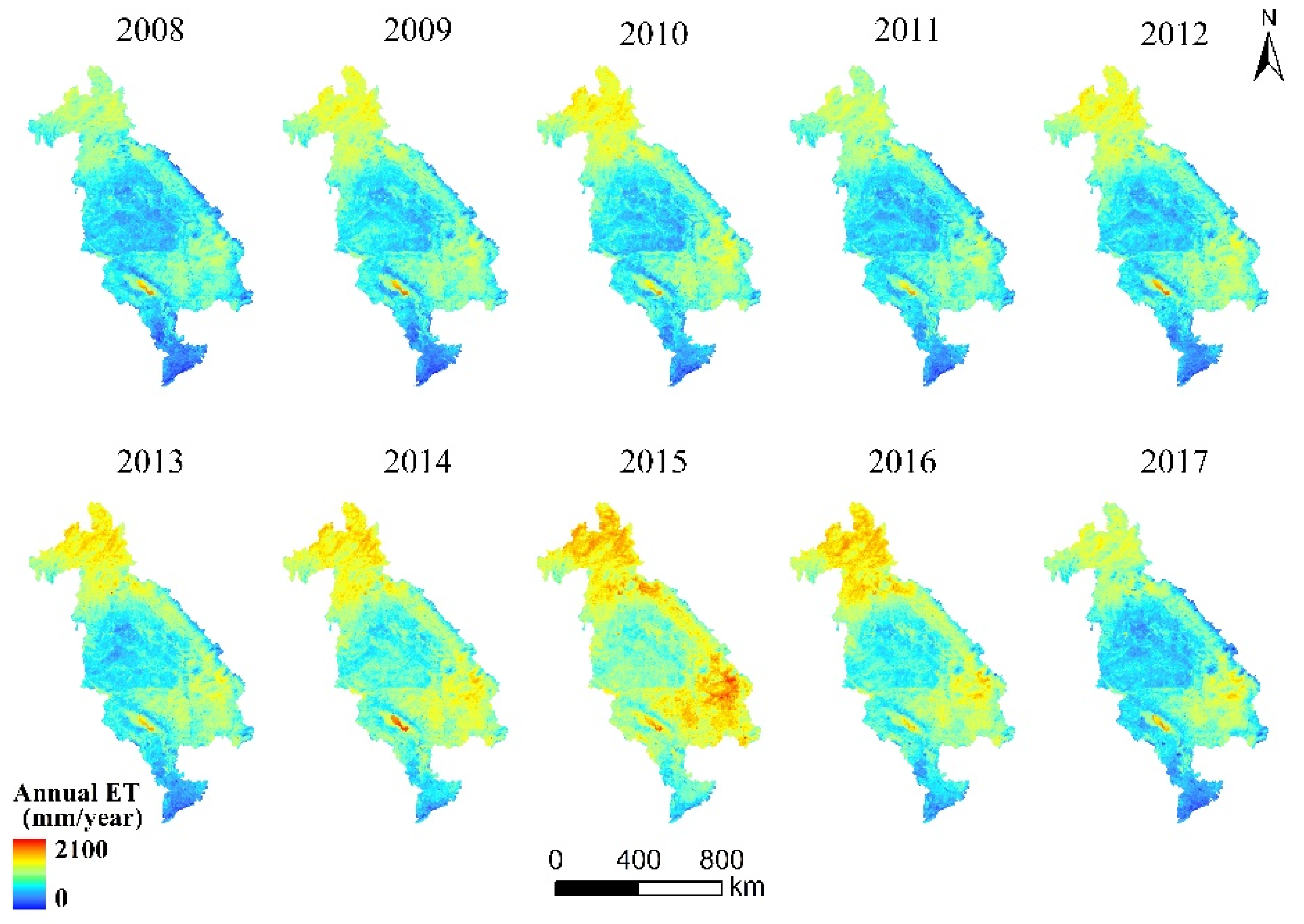
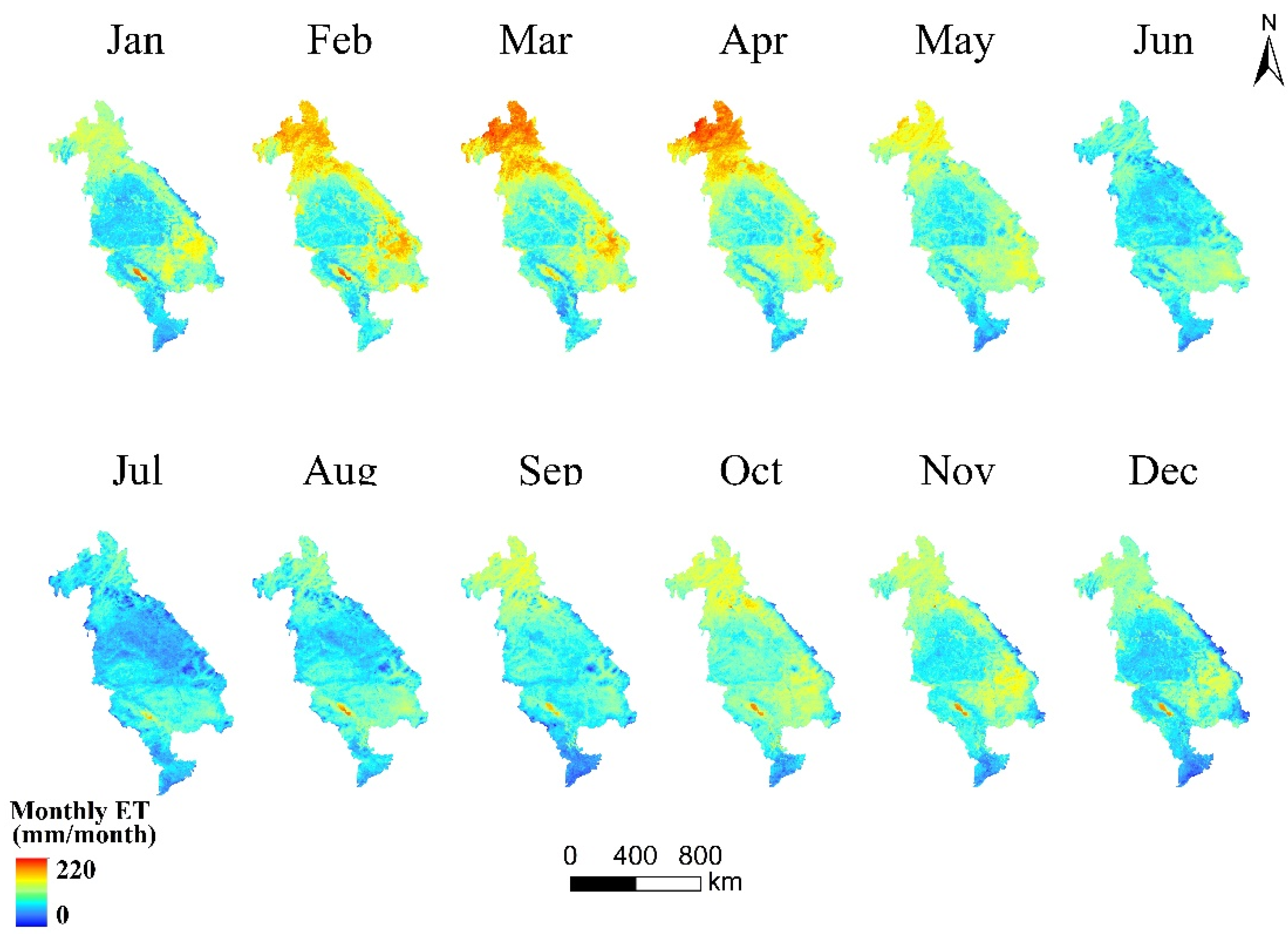
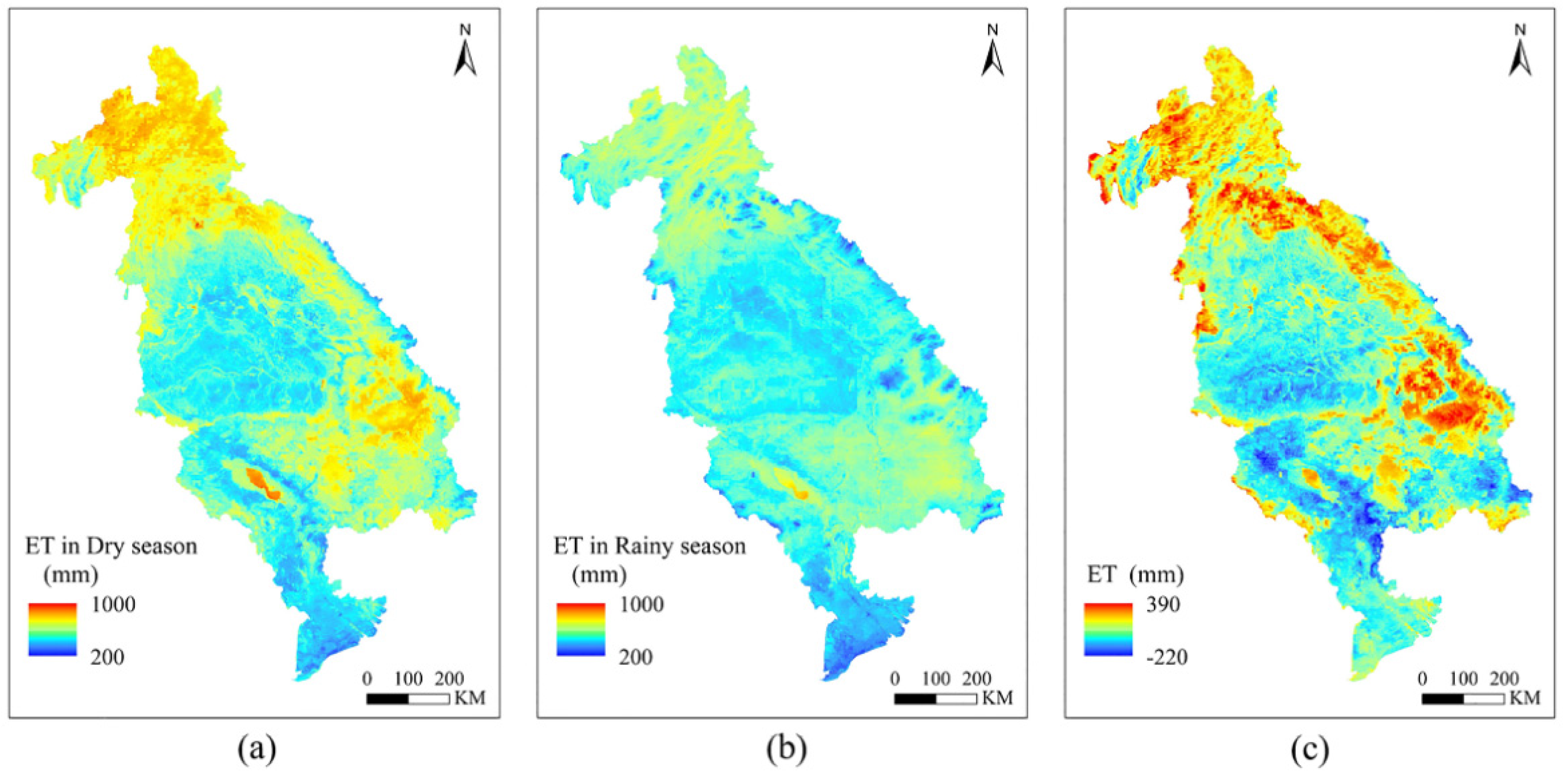


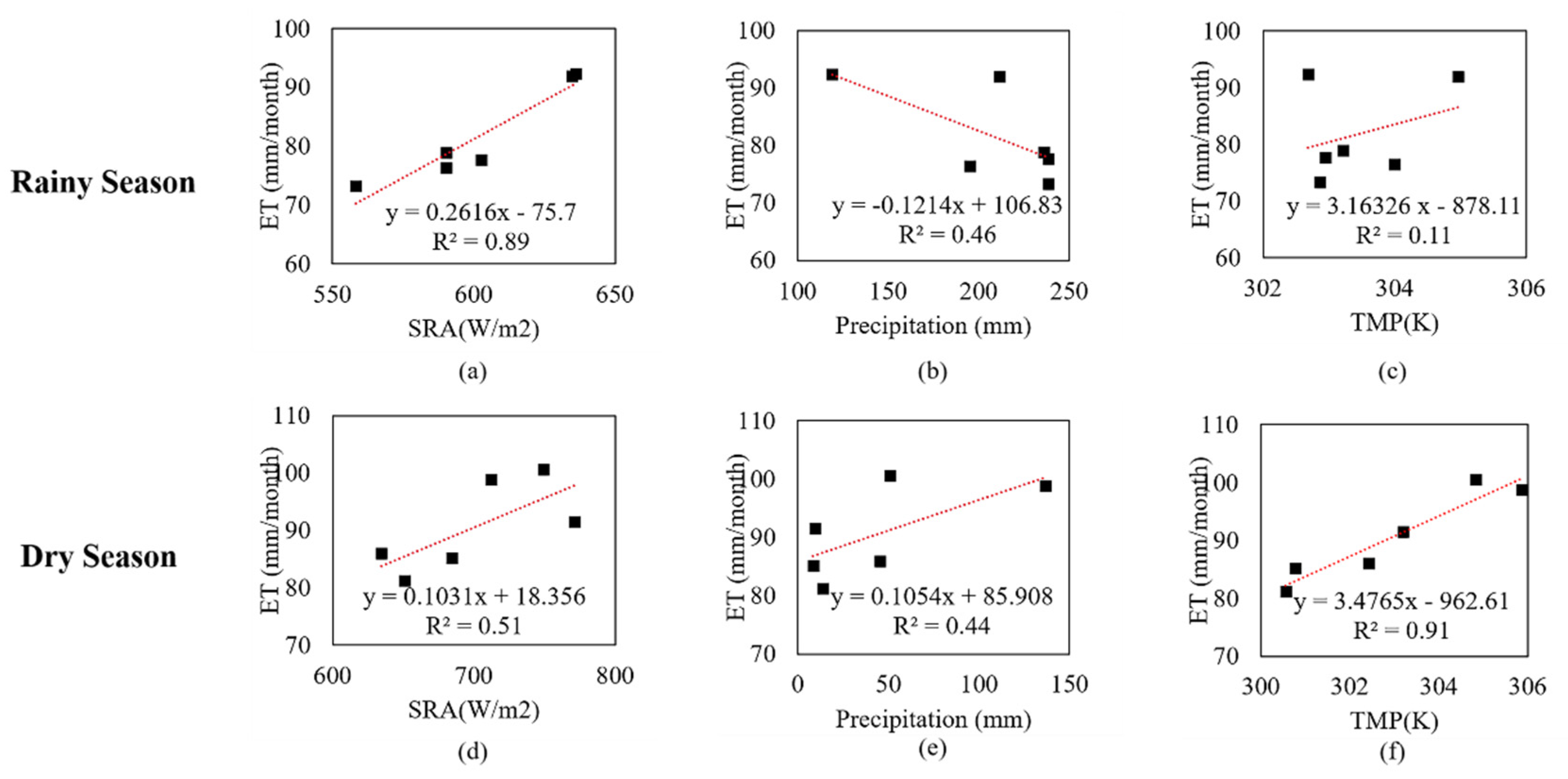
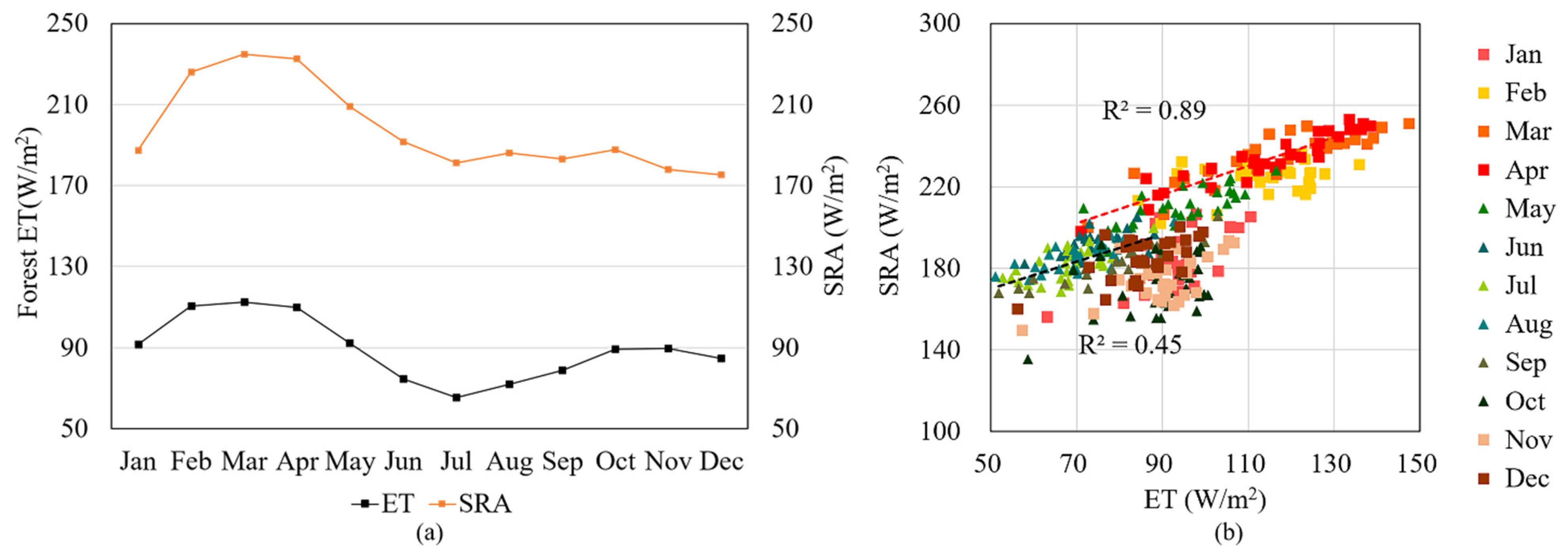
| Data Name | Parameters | Temporal/Spatial Resolution | Data Types |
|---|---|---|---|
| MYD06 | Cloud emissivity & Cloud top temperature | daily/1 km | Remote Sensing (Retrieval) |
| MYD09 | Near-subsolar point reflectance | 8-day/500 m | Remote Sensing (Retrieval) |
| MYD11 | Land surface temperature & emissivity | 8-day/1 km | Remote sensing (Retrieval) |
| MCD12 | Land cover data | 1 year/500 m | Remote sensing (Analyze) |
| CLDAS | Barometric pressure, Shortwave downwelling radiation, Relative humidity, Temperature | 1 h/6 km | Reanalysis (Retrieval) |
| MOD16 | ET | 8-day/1 km | Remote Sensing (Validation) |
| Trend TSslope | Significance Classification | |
|---|---|---|
| > 0 | 0.5 | Slight increase |
| 0.5 | Significant increase | |
| < 0 | 0.5 | Slight increase |
| 0.5 | Significant increase |
| 2017 (km2) | 2008 (km2) | Total | ||||||
|---|---|---|---|---|---|---|---|---|
| Grasslands | Urban | Forest | Croplands | Savannas | Wetlands | Water Area | ||
| Grasslands | 40,123.13 | 0.00 | 4287.44 | 3316.01 | 11,596.82 | 326.95 | 13.19 | 591,715.91 |
| Urban lands | 29.84 | 2743.94 | 0.00 | 62.44 | 26.30 | 0.48 | 0.00 | 2863.00 |
| Forest lands | 568.82 | 0.00 | 185,323.80 | 200.65 | 11,340.43 | 53.55 | 0.94 | 197,506.18 |
| Croplands | 11,706.40 | 0.00 | 191.50 | 188,725.73 | 4575.23 | 117.81 | 0.95 | 205,318.32 |
| Savannas | 8291.59 | 0.00 | 29,425.92 | 5062.51 | 119,151.95 | 141.89 | 0.00 | 162,076.53 |
| Wetlands | 427.63 | 0.00 | 142.70 | 247.9 | 349.64 | 10,481.78 | 137.70 | 12,077.79 |
| Water area | 56.63 | 0.00 | 85.42 | 8.09 | 79.04 | 25.20 | 5886.54 | 6145.77 |
| Total | 61,258.90 | 2743.94 | 219,457.69 | 197,264.95 | 147,124.76 | 11,177.07 | 6041.42 | |
| Net increase or decrease | −1543.09 | 119.06 | −21,951.51 | 8053.37 | 14,951.77 | 900.72 | 104.75 | |
Publisher’s Note: MDPI stays neutral with regard to jurisdictional claims in published maps and institutional affiliations. |
© 2022 by the authors. Licensee MDPI, Basel, Switzerland. This article is an open access article distributed under the terms and conditions of the Creative Commons Attribution (CC BY) license (https://creativecommons.org/licenses/by/4.0/).
Share and Cite
Pan, X.; Liu, S.; Yang, Y.; You, C.; Yang, Z.; Xie, W.; Li, T. Spatio-Temporal Characteristics of the Evapotranspiration in the Lower Mekong River Basin during 2008–2017. Remote Sens. 2022, 14, 2609. https://doi.org/10.3390/rs14112609
Pan X, Liu S, Yang Y, You C, Yang Z, Xie W, Li T. Spatio-Temporal Characteristics of the Evapotranspiration in the Lower Mekong River Basin during 2008–2017. Remote Sensing. 2022; 14(11):2609. https://doi.org/10.3390/rs14112609
Chicago/Turabian StylePan, Xin, Suyi Liu, Yingbao Yang, Chaoshuai You, Zi Yang, Wenying Xie, and Tengteng Li. 2022. "Spatio-Temporal Characteristics of the Evapotranspiration in the Lower Mekong River Basin during 2008–2017" Remote Sensing 14, no. 11: 2609. https://doi.org/10.3390/rs14112609
APA StylePan, X., Liu, S., Yang, Y., You, C., Yang, Z., Xie, W., & Li, T. (2022). Spatio-Temporal Characteristics of the Evapotranspiration in the Lower Mekong River Basin during 2008–2017. Remote Sensing, 14(11), 2609. https://doi.org/10.3390/rs14112609







